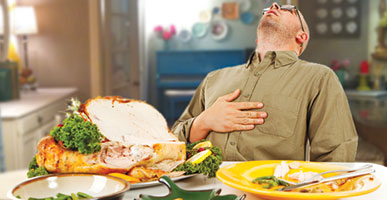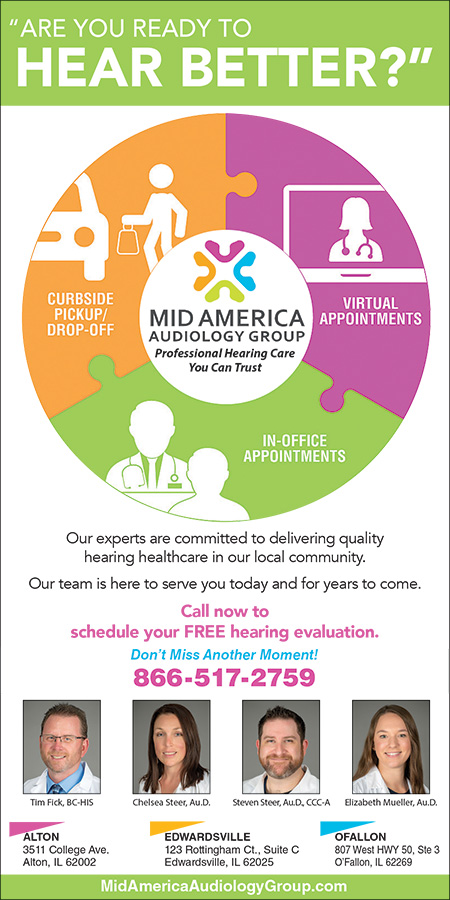That dinner can easily approach 2,000 calories all by itself
 Loosen the belt. Take one more fork-full. You’re close to bursting and you never would have piled your plate like that on a regular day. But, hey, it’s the holidays, and it would be rude not to try every dish, and it all tastes so good, and some of it is healthful and, oh, what the heck — pass the pie!
Loosen the belt. Take one more fork-full. You’re close to bursting and you never would have piled your plate like that on a regular day. But, hey, it’s the holidays, and it would be rude not to try every dish, and it all tastes so good, and some of it is healthful and, oh, what the heck — pass the pie!
Research has proved what we already know: Our brains can easily override our bodies’ signals to stop eating, even when we know the consequences will be unpleasant. We’re not even talking about obesity, heart disease, diabetes or effects of long-term overeating. This is about the short-term awfulness that can follow a high-fat, high-calorie holiday free-for-all.
There is no such thing as an average dinner, dietitians say, but a meal of 600 to 800 calories fits nicely into the 2,000-calorie daily diet.
That holiday dinner, on the other hand, can easily approach or exceed 2,000 calories all by itself, especially if you dig into the appetizers before dinner and wash it all down with a couple of glasses of wine. (One estimate put a typical holiday dinner as high as 4,500 calories, but that would be extremely difficult for most stomachs to stomach.)
Say you just had a heaping helping of pecan pie, egg nog, sweet potatoes with marshmallows and pecans, cornbread stuffing, cranberry sauce, mini croissant, green bean casserole, mashed potatoes with gravy, turkey or baked ham, and a glass of red wine.
HOW YA FEELING NOW, BUNKY?
How that foodfest sits with you afterwards depends on your genes, your body composition, your system’s response to certain hormones and your regular eating and exercise habits.
BLOATED AND DROWSY
The avalanche of food sends the digestive system into overdrive, slowing other functions. Insulin and other hormones are released to break up the carbs. Blood sugar spikes, then plummets.
As you scarf food and drinks (especially fizzy beverages), you swallow excess air. In addition, gut bacteria produce extra gas as they break down sugars and starches. It’s gotta come out somehow.
How much did that food weigh? Two pounds? Three? The sheer weight of what you just shoveled in can make you feel sluggish, especially if you don’t eat that much very often.
Blood rushing to the digestive system abandons less critical areas such as other muscles and skin, so some people feel cold. After the first 750 calories or so, your body begins to store a larger percentage of food as fat. A study found that the average adult gains a pound during each holiday season, and many never lose it.
HOLIDAY EATING TIPS
So, how can avoid feeling lousy after a holiday meal?
• Quench your thirst first. It sounds simple, but be sure you’re always well hydrated by drinking plenty of water before arriving at any holiday celebration. Avoid drinking too many cocktails or glasses of wine as alcohol and mixers contain a lot of empty calories, as do sodas and too many fruit juices.
Make it a rule to never drink alcohol on an empty stomach, since the alcohol will be absorbed too rapidly on an empty stomach and increase your likelihood to overindulge. Before drinking any alcohol, be sure to always eat a small snack or some kind of protein by nibbling on a few nuts or a small slice of cheese. This will cause your stomach to empty slower and will help slow down the absorption rate of alcohol.
• Plan ahead. Acknowledge that you are going to be pigging out and factor that in. If you are having a big holiday dinner, then eat lighter for breakfast and lunch, or focus on higher-fiber fruits and vegetables. Limit those big meals to one a day. Don’t have pancakes for breakfast on the same day you have Thanksgiving turkey. Save it for later in the week.
• Mind your portions. You can still indulge in your favorite foods instead of banning them completely. And you do not have to eat tiny portions. The trick is to eat larger portions of healthy foods balanced with smaller portions of more indulgent and high-calorie choices.
• Try eating off of red plates. This may sound silly. Red is a festive color and red plates certainly go with the season. New research published in the journal Appetite found that we eat less when eating food on a red plate. Subjects who were given pretzels on a red plate ate significantly less than those given pretzels on a blue or white plate. Who knew? The authors suggest that the color red may work as a subtle stop signal (like a red traffic light) which may guide us to reduce our intake.
• Wait on seconds. It often takes our bodies 20 minutes or more to fill up. Unfortunately, we will eat to the point of fullness, only to have the real feeling of full kick in later. By that time, we are overfull and feeling icky. Take your time at meals. Sit, talk and take a break. Give time for your body to fill up before getting seconds.
• Exercise before you eat. Exercisers who work out 12 or fewer hours before a big meal fare better than others. Their bodies tend to have a more sensitive insulin response, allowing them to process the excess carbs more efficiently, and a more robust circulatory system to weather the influx of fat circulating in blood.
What can you do after the deed is done? DON’T lie down, or many of these problems may be exacerbated. Helping to clean up the post-dinner mess would be a 170-calorie-per-hour head start on recovering from the feast.


